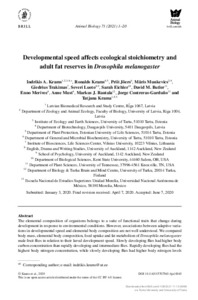Developmental speed affects ecological stoichiometry and adult fat reserves in Drosophila melanogaster
Sarah Eichler; David M. Butler; Ronalds Krams; Priit Jõers; Jorge Contreras-Garduño; Markus J. Rantala; Enno Merivee; Severi Luoto; Anne Must; Indrikis A. Krams; Tatjana Krama; Māris Munkevics; Giedrius Trakimas
https://urn.fi/URN:NBN:fi-fe2021042826474
Tiivistelmä
The elemental composition of organisms belongs to a suite of functional traits that change during development in response to environmental conditions. However, associations between adaptive variations in developmental speed and elemental body composition are not well understood. We compared body mass, elemental body composition, food uptake and fat metabolism of Drosophila melanogaster male fruit flies in relation to their larval development speed. Slowly developing flies had higher body carbon concentration than rapidly developing and intermediate flies. Rapidly developing flies had the highest body nitrogen concentration, while slowly developing flies had higher body nitrogen levels than flies with intermediate speed of development. The carbon-to-nitrogen ratio was therefore lower in rapidly developing flies than in slow and intermediate flies. We also had a group of flies grown individually and their body mass and elemental body composition were similar to those of rapidly developing individuals grown in groups. This suggests that rapid growth is not suppressed by stress. Feeding rates were lowest in the slowly developing flies. The amount of triacylglycerides was highest in the flies with intermediate developmental speed which optimizes development under many climatic conditions. Although low food intake slows down developmental speed and the accumulation of body fat reserves in slowly developing flies, their phenotype conceivably facilitates survival under higher stochasticity of their environments. Rapidly developing flies grew with less emphasis on storage build-up. Overall, this study shoes that a combination of bet-hedging, adaptive tracking and developmental plasticity enables fruit flies to respond adaptively to environmental uncertainty.
Kokoelmat
- Rinnakkaistallenteet [19207]
